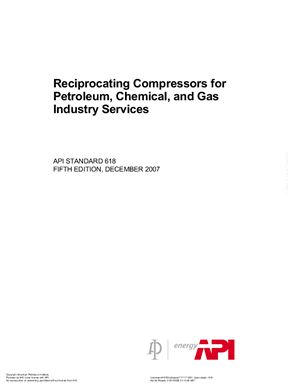API STANDARD 618
FIFTH EDITION, DECEMBER 2007
This standard is based on the accumulated knowledge and experience of manufacturers and users of reciprocating compressors. The objective of this publication is to provide a purchase specification to facilitate the procurement and manufacture of reciprocating compressors for use in petroleum, chemical, and gas industry services. The primary purpose of this standard is to establish minimum requirements. Energy conservation is of conce and has become increasingly important in all aspects of equipment design, application, and operation. Thus, innovative energy-conserving approaches should be aggressively pursued by the manufacturer and the user during these steps. Alteative approaches that may result in improved energy utilization should be thoroughly investigated and brought forth. This is especially true of new equipment proposals since the evaluation of purchase options will be based increasingly on total life costs as opposed to acquisition cost alone. Equipment manufacturers, in particular, are encouraged to suggest alteatives to those specified when such approaches achieve improved energy effectiveness and reduced total life costs without the sacrifice of safety or reliability. This standard requires the purchaser to specify certain details and features. Although it is recognized that the purchaser may desire to modify, delete, or amplify sections of this standard, it is strongly recommended that such modifications, deletions, and amplifications be made by supplementing this standard, rather than by rewriting or incorporating sections thereof into another standard. For effective use of this standard and ease of reference to the text, the use of the data sheets in Annex A is recommended. Users of this standard should be aware that further or differing requirements may be needed for individual applications. This standard is not intended to inhibit a vendor from offering, or the purchaser from accepting, alteative equipment or engineering solutions for the individual application. This may be particularly applicable where there is innovative or developing technology. Where an alteative is offered, the vendor should identify any variations from this standard and provide details.
FIFTH EDITION, DECEMBER 2007
This standard is based on the accumulated knowledge and experience of manufacturers and users of reciprocating compressors. The objective of this publication is to provide a purchase specification to facilitate the procurement and manufacture of reciprocating compressors for use in petroleum, chemical, and gas industry services. The primary purpose of this standard is to establish minimum requirements. Energy conservation is of conce and has become increasingly important in all aspects of equipment design, application, and operation. Thus, innovative energy-conserving approaches should be aggressively pursued by the manufacturer and the user during these steps. Alteative approaches that may result in improved energy utilization should be thoroughly investigated and brought forth. This is especially true of new equipment proposals since the evaluation of purchase options will be based increasingly on total life costs as opposed to acquisition cost alone. Equipment manufacturers, in particular, are encouraged to suggest alteatives to those specified when such approaches achieve improved energy effectiveness and reduced total life costs without the sacrifice of safety or reliability. This standard requires the purchaser to specify certain details and features. Although it is recognized that the purchaser may desire to modify, delete, or amplify sections of this standard, it is strongly recommended that such modifications, deletions, and amplifications be made by supplementing this standard, rather than by rewriting or incorporating sections thereof into another standard. For effective use of this standard and ease of reference to the text, the use of the data sheets in Annex A is recommended. Users of this standard should be aware that further or differing requirements may be needed for individual applications. This standard is not intended to inhibit a vendor from offering, or the purchaser from accepting, alteative equipment or engineering solutions for the individual application. This may be particularly applicable where there is innovative or developing technology. Where an alteative is offered, the vendor should identify any variations from this standard and provide details.

